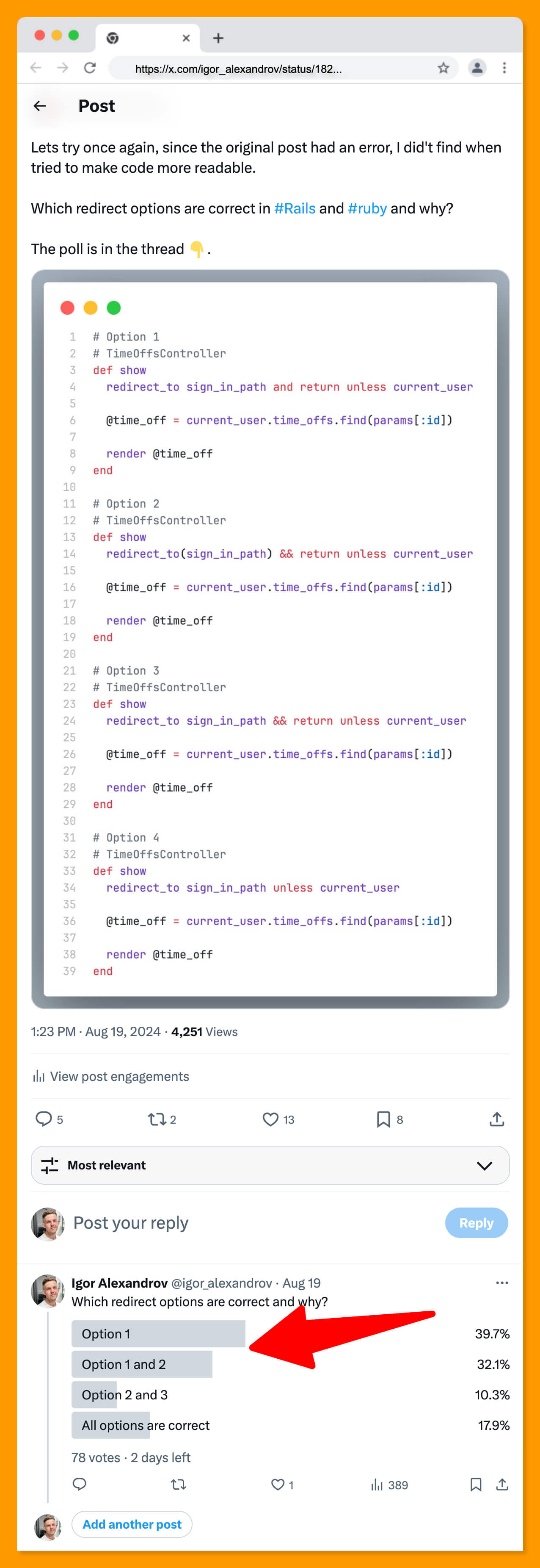Premature returning from a controller action is a common idiom in Rails applications. I asked my followers in Twitter about whether they know or know how to do this correctly, and I am glad to see that most of them gave the correct answer. Let’s dive into the details.
Before we start, I suggest you to take a look at the post, I mentioned above, to see the answers and to try to solve the problem by yourself. If, for some reason, you can’t or don’t want to do this, I created a screenshot for you.

Most of those who votes made the right choice. Correct answers were options 1 and 2. I usually use the first one, but the second option was also correct.
To understand why the first and the second options are correct, I recommend you to read the table of operator precedence in Ruby.
&& operator in options 2 and 3
Using && in options 2 and 3 is a bit tricky.
redirect_to(sign_in_path) && return
In the expression above, && operator get the result of redirect_to(sign_in_path) as the left operand and return as the right operand. This expression will work correct.
redirect_to sign_in_path && return
However, without explicit brackets, && get the result of sign_in_path as the left operand and return as the right operand. The value of the return keyword is nil, so the expression above can be rewritten as:
redirect_to sign_in_path && nil
Whatever && nil will return nil, and redirect_to will be called with nil as an argument, which finally will raise an error.
ActionController::ActionControllerError in TimeOffsController#new
Cannot redirect to nil!
Option 4
There was no way to vote for the fourth option directly, but there were a few who said that all options were correct.
def show
redirect_to sign_in_path unless current_user
@time_off = current_user.time_offs.find(params[:id])
render @time_off
end
In Rails, redirect_to does only sets correct response headers and status code, but it doesn’t stop the execution of the action. In the example above, if current_user is nil, you will face DoubleRenderError.
AbstractController::DoubleRenderError in TimeOffsController#new
Render and/or redirect were called multiple times in this action.
UPD. Difference between && and and
Above in the post, I posted the link to the table of operator precedence in Ruby. Both && and and are logical operators in Ruby, but they have different precedence, && has higher precedence than and. This difference in precedence can lead to unexpected behavior when they are used in complex expressions.
# Using &&
a = true && false
b = false && true
puts a # => false
puts b # => false
# Using and
c = true and false
d = false and true
puts c # => true
puts d # => false
Pretty interesting, right?
In the first case &&, the assignment happens after evaluating the expression, so a and b are both assigned the result of the logical operation false.
In the second case and, the assignment happens before the logical operation because and has lower precedence than =. So c is first assigned true, and then the logical and operation is evaluated, which does not affect the assignment.
Let’s take a look at the another example.
# Using &&
a = b = false && true
puts a # => false
puts b # => false
# Using and
c = d = false and true
puts c # => false
puts d # => false
With &&, both a and b are assigned the result of false && true, which is false.
With and, d = false is evaluated first (due to and’s lower precedence), and then c = d is assigned.
You should be careful when using and and && in complex expressions. It is better to use && for logical operations, while and can be used to control flow.
Conclusions
Despite the fact my post was about Ruby operator precedence, there were people who suggested that it is better to use before_action for such kind of checks. I agree. I will try to be more explicit in my future posts and will provide more context.
Nevertheless, I hope you learned something new. Stay tuned!